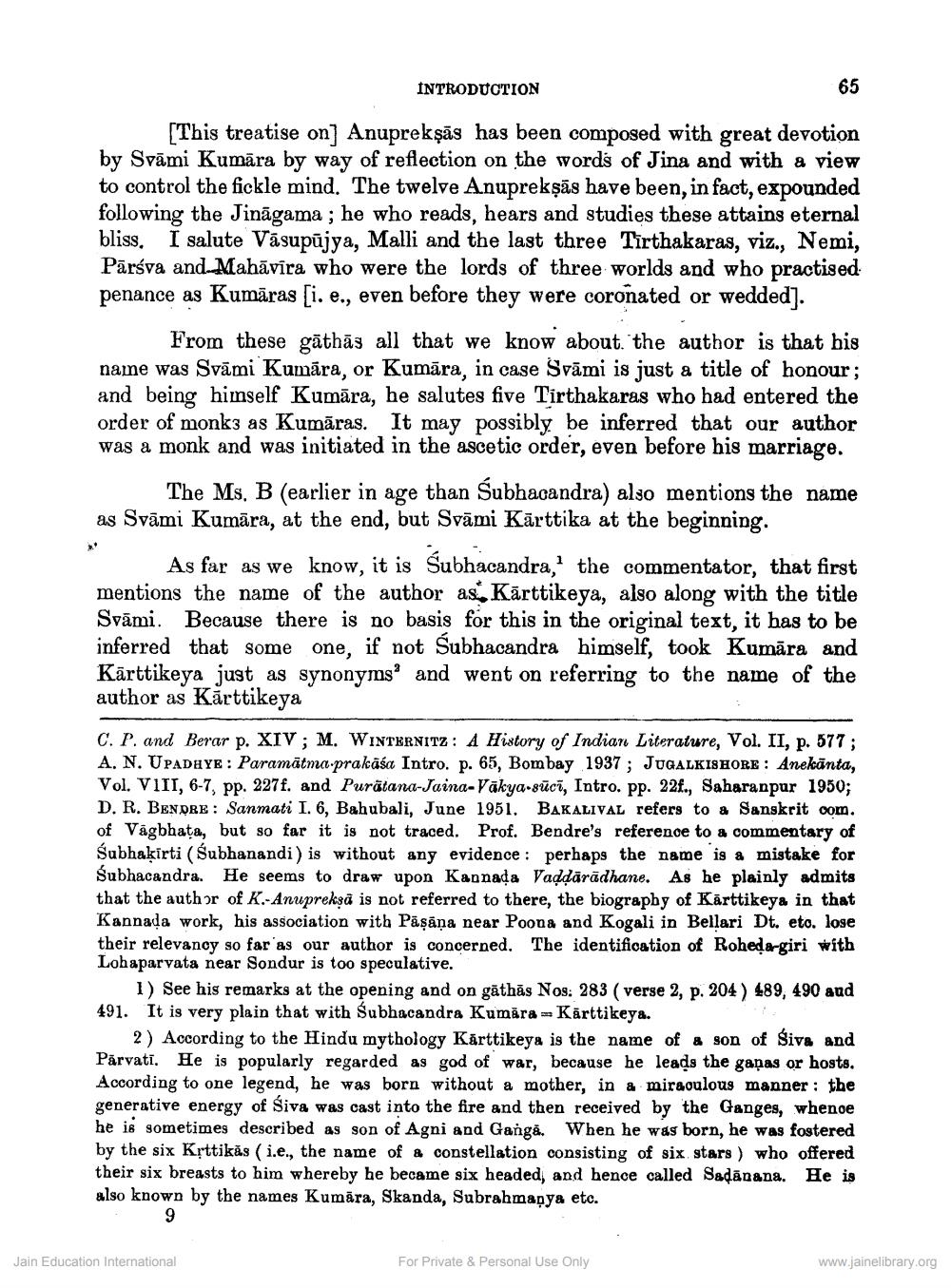________________
INTRODUCTION
65
[This treatise on] Anuprekşās has been composed with great devotion by Svāmi Kumāra by way of reflection on the words of Jina and wit to control the fickle mind. The twelve Anuprekşās have been, in fact, expounded following the Jināgama ; he who reads, hears and studies these attains eternal bliss. I salute Vāsupūjya, Malli and the last three Tirthakaras, viz., Nemi,
Pārsva and Mahāvīra who were the lords of three worlds and who practised penance as Kumāras [i. e., even before they were coronated or wedded].
From these gāthās all that we know about the author is that his name was Svāmi Kumāra, or Kumāra, in case Svāmi is just a title of honour; and being himself Kumāra, he salutes five Tirthakaras who had entered the order of monks as Kumāras. It may possibly be inferred that our author was a monk and was initiated in the ascetic order, even before his marriage.
The Ms. B (earlier in age than Subhacandra) also mentions the name as Svāmi Kumāra, at the end, but Svāmi Kārttika at the beginning.
As far as we know, it is Subhacandra, the commentator, that first mentions the name of the author as, Kārttikeya, also along with the title Svāmi. Because there is no basis for this in the original text, it has to be
erred that some one, if not Subhacandra himself, took Kumāra and Kārttikeya just as synonyms and went on referring to the name of the author as Kārttikeya
C. P. and Berar p. XIV; M. WINTERNITZ: A History of Indian Literature, Vol. II, p. 577; A. N. UPADAYE: Paramātma.prakāśa Intro. p. 65, Bombay 1937; JUGALKISHORE : Anekānta, Vol. VIII, 6-7, pp. 227f. and Purätana-Jaina-Vākya-sūcē, Intro. pp. 22f., Saharanpur 1950; D. R. BENDRE : Sanmati I. 6, Bahubali, June 1951. BAKALIVAL refers to a Sanskrit com. of Vägbhata, but so far it is not traced. Prof. Bendre's referenoe to a commentary of Subhaķirti (Subhanandi) is without any evidence : perhaps the name is a mistake for Subhacandra. He seems to draw upon Kannada Vaddārādhane. As he plainly admits that the author of K.-Anupreksā is not referred to there, the biography of Kārttikeya in that Kannada work, his association with Pāşāņa near Poona and Kogali in Bellari Dt. eto. loge their relevancy so far as our author is concerned. The identification of Roheda-giri with Lohaparvata near Sondur is too speculative.
1) See his remarks at the opening and on gathās Nos: 283 ( verse 2, p. 204) 489, 490 and 491. It is very plain that with Subhacandra Kumāra - Kärttikeya.
2) According to the Hindu mythology Kárttikeya is the name of a son of Siva and Părvati. He is popularly regarded as god of war, because he leads the gaņas or hosts. According to one legend, he was born without a mother, in a miraculous manner : the generative energy of Siva was cast into the fire and then received by the Ganges, whenoe he is sometimes described as son of Agni and Ganga. When he was born, he was fostered by the six Krttikås (i.e., the name of a constellation consisting of six stars ) who offered their six breasts to him whereby he became six headed, and hence called Sadānana. He is also known by the names Kumāra, Skanda, Subrahmanya etc.
Jain Education International
For Private & Personal Use Only
www.jainelibrary.org




